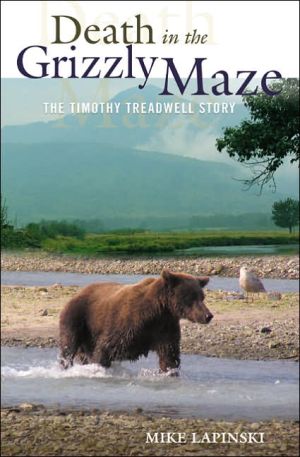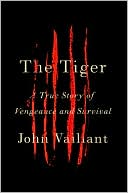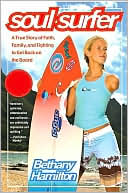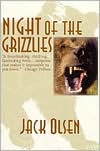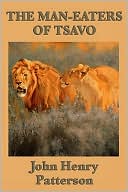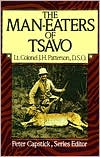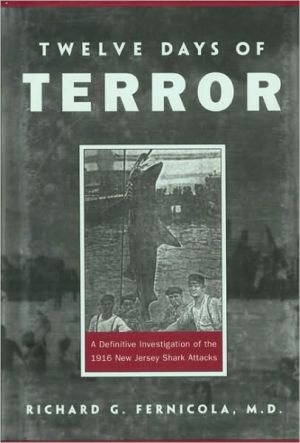Death in the Grizzly Maze: The Timothy Treadwell Story
On the afternoon of Sunday, October 5, 2003, in Alaska's Katmai National Park, one or more brown bears killed and ate Timothy Treadwell and his girlfriend, Amie Huguenard. The next day, park rangers investigating the site shot and killed two bears that threatened them; it was later determined that one of the bears had human flesh and clothing in its stomach.\ This chilling story immediately captured worldwide media attention, not only because of the horrific manner of Timothy and Amie's...
Search in google:
On the afternoon of October 5, 2003, in Alaska's Katmai National Park, one or more brown bears killed and ate Timothy Treadwell, a well-known wildlife celebrity, and his girlfriend Amie Huguenard. This frightening and chilling story immediately captured worldwide media attention and ignited a firestorm of controversy. Death in the Grizzly Maze is the compelling account of Treadwell's intense life and dramatic death. Author Mike Lapinski chronicles Treadwell's rise from self-described alcoholic loser to popular grizzly-bear advocate, and he delves into the troubling issues raised by a new breed of wildlife celebrities.
Breaking the Rules in Bear Country\ It was finally dark...Suddenly, I felt the ground shake and the crush of grass being trampled outside my tent. A bear was bedding down for the evening. Without alarm, I left the tent, shining my flashlight into the pitch-black evening and saw Mr. Chocolate, my beautiful half-ton friend, who had stopped by to spend the evening with me..."Good night, big fellow, and sleep tight," I crooned. "We're gonna have a great day tomorrow."--Timothy Treadwell, Among Grizzlies\ Night descended upon the Run Amuck Campground northeast of Ketchikan, Alaska, as George Tullos, a forty-one-year-old resident of Ketchikan crawled into his tent, feeling snug and safe after a long day of watching bears.\ And why not? He was in a well-used camping area in a place where the big brown (coastal grizzly) bears were thought to be benign because thousands of spawned-out salmon clogged the nearby river and provided an abundance of food. The spot was so safe that the Forest Service maintained a bear-viewing platform three miles away along the river, where people could watch bears passing by as close as twenty yards away as the bloated bruins blissfully gorged on dead salmon.\ Tullos was stirred awake during the night by the shaking of the ground and the crush of grass outside his tent. He probably poked his head outside his tent with flashlight in hand. The next morning, a passerby found the Tullos campsite torn apart, and investigating rangers discovered the partially eaten body of George Tullos. A short time later, they encountered a brown bear and killed it. A necropsy found human flesh in its belly, along with berries and grass.\ Back at Katmai, Timothy Treadwell emerged from his tent, stretching and yawning, and set out to find his good friend Mr. Chocolate among the dozens of brown bears roaming within a mile of his campsite. He wrote, "I sat only 30 feet away, watching and photographing Mr. Chocolate, a half-ton brown male grizzly bear, who paused between bites and gazed up toward me, not concerned at all by my presence as he ate...throughout the years, Mr. Chocolate had not only tolerated my presence, but seemed to enjoy it."\ Ironically, George Tullos, who always kept a clean camp and made it a practice to observe bears at a distance, fell victim to claw and fang, while Timothy Treadwell lived, despite the fact that he'd repeatedly violated most of the rules for proper behavior in bear country.\ Timothy ignored these simple rules, at first out of ignorance; later out of a growing conviction that the bears accepted and trusted him. Beginning with his very first foray into bear country, Timothy exhibited a disturbing lack of judgment, largely attributable to his admitted naiveté as an outdoorsman.\ After traveling to Alaska in 1989 and learning where to find bears, Timothy set shortly after lunch on a drizzly August afternoon in Katmai National Park. Hiking along a major bear trail, he began finding huge piles of bear droppings, black and squishy from fish oil. He waited for hours at a place where the trail followed a river, but no bears appeared. Timothy penned his thoughts: "I waited in the rain, getting soaked as my cheap raincoat failed. And when it wasn't raining, the mosquitoes and white socks bit and gnawed at my flesh. Tears of frustration welled up in my eyes. All I wanted was the company of bears."\ As the long Alaska day ended at about 11 P.M., Timothy started back to camp along the gloomy forest trail he'd traveled hours earlier, the path now dark and slick in the pouring rain. Suddenly, branches snapped and cracked just ahead. Timothy Treadwell was about to get his wish.\ "In the dim light," he reminisced, "a massive form took shape, definitely not human. As the bear slowly ambled my way, fear enveloped me. My body told me to run, but my brain knew better. Without turning my back on the bear, I slowly retreated and started singing softly. What I sang, I haven't a clue, but it calmed my frazzled nerves. Maybe it communicated some goodwill to the approaching bear because the animal veered to my left and disappeared into the night. I shook with adrenalin spiked with fear. Triumphantly, I resumed the hike back to camp."\ After another bear encounter that ended the same way, Timothy was feeling pretty shaken and wanted only to get back to camp because it was almost dark. Then the vague outline of another bear loomed ahead in the trail.\ "This brown bear was massive, possibly weighing 1,000 pounds. On all fours, the bear's head was as high as mine. Again I attempted to back up and sing sweet songs, but the bear came too fast and quickly closed the distance between us. I stumbled on the mud and fell face-first. As I curled into a fetal position, the grizzly's steps vibrated right next to my sniveling face. Pearl-dagger claws stopped inches from my cheek.\ "Spreading my fingers over my eyes in a bizarre form of peekaboo, I gaped up at the grizzly's face. What little light was left exposed an immense, furry face horribly engraved with long, deep scars from battles past. The bear exhaled a puff of fish-breath, then quickly inhaled my odor. No brilliant defensive strategy occurred to me. The grizzly hovered above for a few minutes, but for me, it was a lifetime. Then, ever so gently, he stepped over my quivering body, his bloated tummy scraping across my right shoulder, and vanished into the night.\ "After he was gone, I picked up my shaking body and stumbled along the path, all the while chanting, 'Thank you, bears...thank you, bears.' This brush with the wild grizzly was more than I had hoped for."\ On his very first outing, Timothy Treadwell had violated two cardinal rules: Never hike in the dark, and never go looking for bears. Bear experts often don't even bother to warn hikers about traveling through bear country in the dark because the danger is so obvious.\ In retrospect, it might even have been a life-saving, though painful, experience at that embryonic stage of his bear vision quest, if that half-ton grizzly had swatted Timothy Treadwell with a sledge hammer-like blow and busted a half dozen of his ribs, or shaken him like a rat while crushing the bones in his shoulder.\ But Timothy got lucky. The bear passed without incident, no doubt bolstering his budding notion that if you love bears, they'll love you back. What ultimately brought Timothy fame among bear lovers, and incurred the wrath of bear experts, was his continual practice of getting close to grizzlies. Timothy moved toward bears over and over again without being attacked, though he had many close calls. In one day, a single bear charged him three different times. On his first trip to a place in Katmai National Park he called the "Grizzly Sanctuary," Timothy recorded his first close encounter during which he willfully moved toward a bear. Katmai, it turned out, was an ideal location for getting the closeness that he craved.\ Located 30 miles west of Kodiak Island via the Shelikof Straight, Katmai National Park was created to preserve the famed Valley of Ten Thousand Smokes, a spectacular forty square mile pyroclastic ash flow deposited by the Novarupta Volcano. Currently, there are fourteen volcanos in Katmai that are considered active, though none are currently erupting. It's no surprise that Timothy Treadwell would choose Katmai National Park for the staging ground of his star-crossed odyssey. It had everything he needed: fantastic scenery, wilderness, isolation, lots of big brown bears--and a perplexingly cordial staff.\ In the beginning, Katmai received some attention from geologists and volcano lovers, but attendance didn't come close to matching the envious attendance record of its sister park to the northeast--Denali, where tens of thousands of animal lovers vied for the privilege of viewing its wildlife. It wasn't that Katmai didn't have bears. More than 2,000 of the giant brown bears roamed its shores and inland forests, sustained by a series of salmon spawning runs that saw millions of the dying fish struggling up its numerous fresh water streams that flow into the ocean. The big problem at Katmai was access. It was truly a wilderness park, with no roads slicing through the heart of it like at Denali. At Katmai, you either flew or boated to get anywhere in the park, and then you were stuck there until you flew or boated out.\ Katmai was officially "discovered" when the Exxon Valdez ran aground in Prince William Sound. This catastrophic oil spill in 1986 threatened to destroy hundreds of miles of pristine Alaskan shoreline. Desperate federal officials sent urgent pleas for all charter craft to aid in corralling the spreading black oil slick. Lured by the promise of big bucks, fishing and sight-seeing boats steamed down the Shelikof Straight to help with the oil cleanup.\ It was during these trips back and forth along the Katmai Coast that charter boat captains noticed the large numbers of brown bears roaming in plain view along the shore. After the oil spill was contained, many of these charter boats began offering bear-viewing excursions in the comfort of their fully equipped boats, and added land excursions led by experienced bear guides. Tourism exploded from a meager 3,000 visitors annually, to more than 30,000 today, with 70 commercial operators of bear viewing excursions working within park boundaries.\ Initially, rules and regulation were few at Katmai, since almost all of the bear viewing occurred from boat or plane, with overnight stays a rarity. By contrast, Denali requires anyone planning a camping trip to apply for a back country camping permit and attend a half hour training session. Katmai, on the other hand, didn't even require a camping permit (and still doesn't, except in certain areas). In Denali, visitors are not allowed to move closer than a fs20quarter mile (1400 feet) from any grizzly bear. In Katmai, it's 100 yards from sows with cubs, and only 50 yards from all other bears. These lax rules and regulations, in turn, fostered lax enforcement by park rangers. In other words, Katmai National Park was made to order for Timothy Treadwell.\ Typical of Timothy's behavior in Katmai is a foray he took one morning in the Grizzly Sanctuary, during which he encountered scores of bears feeding on grass. "The sprawling green field was littered with bears. One patch boasted forty and fifty bears. I slowly made my way onto the green, staying a hundred yards away for relatively safe viewing. Slinking about, I discovered a large crater surrounded by fresh bear droppings. I recognized the crater to be a bear daybed. I plopped down in the crater and peeked out over the edge. I couldn't believe it! If anyone had ever told me that one day I'd be lying in a real grizzly bear bed with fifty of them surrounding me, I'd have thought they were crazy."\ "Feeling a sense of contentment, my eyelids grew heavy, and I fell asleep in the bear's bed. Persistent soft crunching stirred me awake and I found myself staring up at a huge grizzly just a few feet from my head. The animal was so gigantic that it blocked out the sun's light, its massive head larger than two basketballs put together. What was I thinking, falling asleep in some giant bear's bed? He continued to graze, glaring at me all the while. He was so close, I could have reached out and patted his damp mouth and chin...I was terrified, yet I couldn't help but marvel at the magnificent animal. At that moment, my future rested in his paws. Without staring directly at him, I sensed something unique about this bear. I began to sing, ever so softly, 'Mr. Chocolate Bear, I'm sorry I'm in your way.'\ "He cocked his head and gingerly backed up a few paces, peering at me. His jaw hung open slightly, in comical fashion. Without knowing why, I felt positive that I could roll out of the crater and safely leave. Carefully, I did just that, and then the bear moved forward and lowered himself into the bed."\ Some bear experts called Timothy's practice of moving close in to the bears crazy and stupid. Biologists, such as Sterling Miller, then an Alaska Fish & Game biologist, and Tom Smith, a research wildlife biologist for the U.S. Geological Survey's Alaska Science Center, counseled Timothy about the message he was sending to the public. Depending upon his mood, Timothy either agreed and said he'd stopped doing it, or blew them off with a flippant remark like, "The bears know me and trust me." Even those few bear experts who felt an affection for Timothy warned him about the effects, and the consequences, of moving in close to bears. Bear folk hero Doug Peacock warned Timothy that he was taking the bears too lightly, and that he was maybe sending the wrong message to the public ( I can do this, but don't you try it).\ Almost from the day Timothy Treadwell set foot in Katmai National Park, he had an impact, though his early visits were notable more for his struggle to survive the harsh living conditions along the Katmai Coast. Wildlife photographer Alan Sanders, an experienced back packer, often queried Timothy about his living conditions. "He never put a shine on his early days, at least to me," Sanders says. "A lot of times he was cold, hungry, bug bit, and scared to death. But year after year he kept coming back. Aboriginal natives in similar conditions built wood or sod shelters. Not Tim, he wanted to have a purely wilderness experience. Like he mentioned in his book, I think he wanted to be a bear."\ And before Timothy became the great communicator with bears, he had his problems just surviving them. Mark Emery, a wildlife filmmaker and outdoor guide, remembers the day when he was on a charter flight across Katmai National Park, and he saw a solitary figure frantically waving his arms skyward.\ The plane landed and a desperate, frightened Timothy Treadwell rushed forward and asked if they'd take him away from there right now. "He said the bears had invaded his camp," Emery recalled. "They chewed up everything. I took a picture of Timothy holding a water can that was crushed by a bear and had big teeth holes in it. There was a fresh water stream close by, but he just wanted away from those bears. I was with a film crew from National Geographic, and we had a schedule to keep, but we contacted a charter service and they came in and picked him up."\ Though the Treadwell name initially surfaced because of his early day camping misadventures, his erratic behavior would bring him much attention-none of it good. Bear viewing tour guides began approaching park rangers with tales of a weird guy acting like a bear and running away, or screaming curses at other bear viewers, or sneaking around and scaring bear viewing parties.\ Biologist Tom Smith told me he often saw "Timmy the bear" as he called him. "He wouldn't come to me. He'd run away like a bear. He was a nut, but there's lots of them out there. I kind of liked the guy. I'd seek him out whenever I saw him, whether he wanted it or not.\ "One time there were two of us walking along the beach, and we found a dead brown bear cub. Its mouth was full of porcupine quills. Timothy's camp was only about a hundred yards away, so we walked over to it and I called his name. I knew he was in there, but he didn't respond. He was strange that way. I finally shook the tent pole and yelled, 'I know you're in there, Tim. Come on out. One of your bears is dead.' Well, he shot right out of the tent and I told him, with tongue in cheek, "Tim, you're supposed to be protecting these bears, but you're not doing a very good job of it. I just found a dead cub a hundred yards away from your tent.' Tim got all serious and spread his arms and said, 'Hey, that's nature!'"\ Had Timothy Treadwell embarked on his mission of personal discovery twenty miles inland, or interior Canada, or even in Glacier or Yellowstone, his tragic end would probably have been moved up about thirteen years. To knowingly advance through thick fog into the midst of feeding bears violated not only the rules of proper behavior in bear country, but also the common sense that experienced woodsmen try to pass on to others to protect themselves. It also put the bears at risk. Should one of those bears have reacted instinctively and injured Timothy, some ranger or state official would have ended up shooting it. Timothy's irresponsible actions that morning in the fog also left me with the unsettling feeling that sooner or later he, and some innocent bears, would pay the price.\ As Timothy Treadwell's name popped up more and more on park rangers' complaint sheets, they started keeping an eye on this strange bear-man. One thing they noticed right off. Treadwell was getting way too close to the bears, and he was camping sometimes right on top of their feeding areas. Though he was never cited for it, rangers often warned him to stay back from the bears and stop stressing them with his hovering presence. Depending upon the day and the particular ranger, Timothy might be friendly and accommodating, or moody and belligerent (usually the former if the ranger was female, the latter if the ranger was male).\ When Deb Liggett took over as Katmai National Park Superintendent in 1997, the park staff set up a meeting specifically to fill her in about Timothy Treadwell, who by then had created quite a rift between himself and the bear viewing operators in Homer. Timothy had attributed to poachers the threat of men stuffing him into a crab pot and sinking him in the ocean, but that threat was actually voiced by an irate bear-viewing guide after Timothy chased away the bears to "keep them safe" from the guide's half-dozen urban tourists.\ Another commercial bear viewer filed a harassment complaint with the park service against Timothy after an altercation, during which the complainant alleged that Treadwell became belligerent and threatening. In a letter to Liggett, Timothy told a far different story, explaining that the entire incident was a misunderstanding: "I was in a neutral area recording the crew's actions, which consisted of them setting up cameras mere feet from the bears. The guide was not pleased with my presence and approached me. I attempted to withdraw because past conversations with commercial operators have had poor results. The guide caught up to me, and we had a cordial conversation."\ After rangers explained to Timothy that he had no legal right to harass or impede commercial bear viewers, the tension eventually eased and Timothy became more accommodating of the steady stream of bear-viewers whose boats nudged up to the Big Green.\ Unfortunately, the bear harassment problems with Timothy did not ease. Rangers were constantly shooing Timothy away from bears who wanted to be left alone, and who showed obvious signs of being stressed. When his book, Among Grizzlies, was published park personnel were startled by the endless accounts of Timothy moving to within mere feet, not only of submissive young females, but also sows with cubs and even dominant boars.\ In the summer of 1998, park rangers began asserting their legal muscle. Four times rangers questioned Timothy at his camp about his food storage practices, and each time Timothy swore that he was complying with park requirements. Rangers inspected his camp while Treadwell was away and found an ice chest containing food in his tent, a violation of park rules. When the rangers looked under a tarp in front of his tent, they found a box of canned fruit and a case of Coca Cola. They then followed a foot path away from his tent and in a grove of trees discovered a portable generator, which was prohibited in a wilderness area.\ While accepting responsibility for leaving his food unsecured in his tent, Timothy protested bitterly about the invasion of his privacy. "I am outraged and hurt," he wrote. "Without ever asking, the rangers unzipped my secure tent and went through my belongings."\ Deb Liggett decided that something had to be done about Timothy Treadwell or she was going to have an injured bear whisperer and some dead bears on her hands. She phoned several of Timothy's acquaintances and asked the question, "What would get Timothy Treadwell's attention?"\ They responded, "Threaten to kick him out of the park."
Introduction: Did Timothy Treadwell Have to Die?; (1) The Timothy Treadwell No One Knew; (2) Breaking the Rules in Bear Country; (3) Men Who Loved Animals to Death; (4) Treadwell Soars to Prominence; (5) What Bear Experts Thought of Treadwell's Exploits; (6) The "Bear Whisperer" Syndrome; (7) Katmai National Park--Treadwell's Place of Triumph and Tragedy; (8) Amie Huguenard's Fatal Attraction to Timothy Treadwell; (9) Tragedy Strikes the Treadwell Camp; (10) Officials Kill the Bears that Killed Treadwell; (11) The World Reacts; (12) Have We Learned Anything from Timothy Treadwell?; Conclusion: People Who Truly Love Bears, Leave Them Alone.
